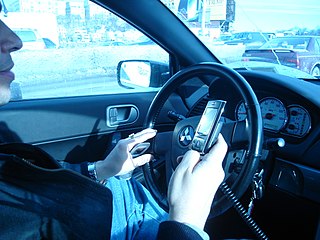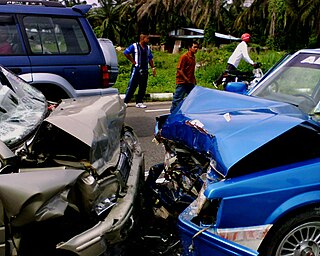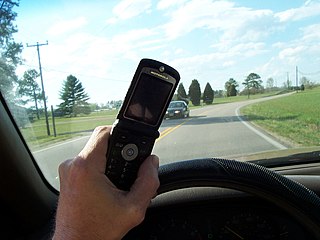
A seat belt is a vehicle safety device designed to secure the occupant of a vehicle against harmful movement that may result during a collision or a sudden stop. A seat belt functions to reduce the likelihood of death or serious injury in a traffic collision by reducing the force of secondary impacts with interior strike hazards, by keeping occupants positioned correctly for maximum effectiveness of the airbag and by preventing occupants being ejected from the vehicle in a crash or if the vehicle rolls over.

Driving is the controlled operation and movement of a motor vehicle, including cars, motorcycles, trucks, and buses. Permission to drive on public highways is granted based on a set of conditions being met and drivers are required to follow the established road and traffic laws in the location they are driving.

A self-driving car, also known as a robot car, autonomous car, or driverless car, is a vehicle that is capable of sensing its environment and moving with little or no human input.

Automotive safety is the study and practice of design, construction, equipment and regulation to minimize the occurrence and consequences of traffic collisions involving motor vehicles. Road traffic safety more broadly includes roadway design.

Road traffic safety refers to the methods and measures used to prevent road users from being killed or seriously injured. Typical road users include: pedestrians, cyclists, motorists, vehicle passengers, horse-riders and passengers of on-road public transport.

Electronic stability control (ESC), also referred to as electronic stability program (ESP) or dynamic stability control (DSC), is a computerized technology that improves a vehicle's stability by detecting and reducing loss of traction (skidding). When ESC detects loss of steering control, it automatically applies the brakes to help "steer" the vehicle where the driver intends to go. Braking is automatically applied to wheels individually, such as the outer front wheel to counter oversteer, or the inner rear wheel to counter understeer. Some ESC systems also reduce engine power until control is regained. ESC does not improve a vehicle's cornering performance; instead, it helps to minimize the loss of control.

Advanced driver-assistance systems (ADAS), are electronic systems that aid a vehicle driver while driving. When designed with a safe human-machine interface, they are intended to increase car safety and more generally road safety.

In road-transport terminology, a lane departure warning system is a mechanism designed to warn the driver when the vehicle begins to move out of its lane on freeways and arterial roads. These systems are designed to minimize accidents by addressing the main causes of collisions: driver error, distractions and drowsiness. In 2009 the U.S. National Highway Traffic Safety Administration (NHTSA) began studying whether to mandate lane departure warning systems and frontal collision warning systems on automobiles.
The National Traffic and Motor Vehicle Safety Act was enacted in the United States in 1966 to empower the federal government to set and administer new safety standards for motor vehicles and road traffic safety. The Act was the first law to establish mandatory federal safety standards for motor vehicles. The Act created the National Highway Safety Bureau. The Act was one of a few initiatives by the government in response to a increasing number of cars and associated fatalities and injuries on the road following a period when the number of people killed on the road had increased 6-fold and the number of vehicles was up 11-fold since 1925.

Mobile phone use while driving is common, but it is widely considered dangerous due to its potential for causing distracted driving and crashes. Due to the number of crashes that are related to conducting calls on a phone and texting while driving, some jurisdictions have made the use of calling on a phone while driving illegal. Many jurisdictions have enacted laws to ban handheld mobile phone use. Nevertheless, many jurisdictions allow use of a hands-free device. Driving while using a hands-free device is not safer than using a handheld phone to conduct calls, as concluded by case-crossover studies, epidemiological, simulation, and meta-analysis. In some cases restrictions are directed only at minors, those who are newly qualified license holders, or to drivers in school zones. In addition to voice calling, activities such as texting while driving, web browsing, playing video games, or phone use in general can also increase the risk of a crash.
Aggressive driving is defined by the National Highway Traffic Safety Administration as the behaviour of an individual who "commits a combination of moving traffic offences so as to endanger other persons or property."

A traffic collision, also called a motor vehicle collision (MVC) among other terms, occurs when a vehicle collides with another vehicle, pedestrian, animal, road debris, or other stationary obstruction, such as a tree, pole or building. Traffic collisions often result in injury, death, and property damage.
When a person makes a claim for personal injury damages that have resulted from the presence of a defective automobile or component of an automobile, that person asserts a product liability claim. That claim may be against the automobile's manufacturer, the manufacturer of a component part or system, or both, as well as potentially being raised against companies that distributed, sold or installed the part or system that is alleged to be defective.

Texting while driving, also called texting and driving, is the act of composing, sending, reading text messages, email, or making similar use of the web on a mobile phone while operating a motor vehicle. Texting while driving is considered extremely dangerous by many people, including authorities, and in some places have either been outlawed or restricted. A survey of more than 90 teens from more than 26 high schools throughout the United States conducted by Liberty Mutual Insurance Group in 2006 showed that 46% of students consider texting to be either "very" or "extremely" distracting. An American Automobile Association study showed that 34% of teens admitted to being distracted behind the wheel because of texting and 40% of American teens say they have been in a car when the driver used a cell phone in a way that put people in danger. A study involving commercial vehicle operators conducted in September 2009 concluded that though incidence of texting within their dataset was low, texting while driving increased the risk of accident significantly.

Electric vehicle warning sounds are sounds designed to alert pedestrians to the presence of electric drive vehicles such as hybrid electric vehicles (HEVs), plug-in hybrid electric vehicles (PHEVs), and all-electric vehicles (EVs) travelling at low speeds. Warning sound devices were deemed necessary by some government regulators because vehicles operating in all-electric mode produce less noise than traditional combustion engine vehicles and can make it more difficult for pedestrians, the blind, cyclists, and others, to be aware of their presence. Warning sounds may be driver triggered or automatic at low speeds; in type, they vary from clearly artificial to those that mimic engine sounds and those of tires moving over gravel.
A connected car is a car that is equipped with Internet access, and usually also with a wireless local area network. This allows the car to share internet access, and hence data, with other devices both inside as well as outside the vehicle. Often, the car is also outfitted with special technologies that tap into the internet or wireless LAN and provide additional benefits to the driver. For safety-critical applications, it is anticipated that cars will also be connected using dedicated short-range communications (DSRC) radios, operating in the FCC-granted 5.9 GHz band with very low latency.
Fatigue detection software is intended to reduce fatigue related fatalities and incidents. Several companies are working on a technology for use in industries such as mining, road- and rail haulage and aviation. The technology may soon find wider applications in industries such as health care and education.

People who are driving as part of their work duties are an important road user category. First, workers themselves are at risk of road traffic injury. Contributing factors include fatigue and long work hours, delivery pressures, distractions from mobile phones and other devices, lack of training to operate the assigned vehicle, vehicle defects, use of prescription and non-prescription medications, medical conditions, and poor journey planning. Death, disability, or injury of a family wage earner due to road traffic injury, in addition to causing emotional pain and suffering, creates economic hardship for the injured worker and family members that may persist well beyond the event itself.


















